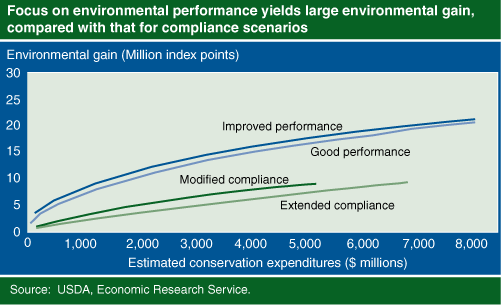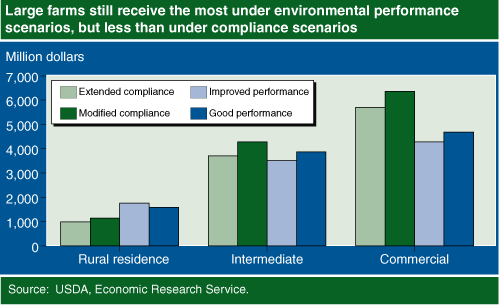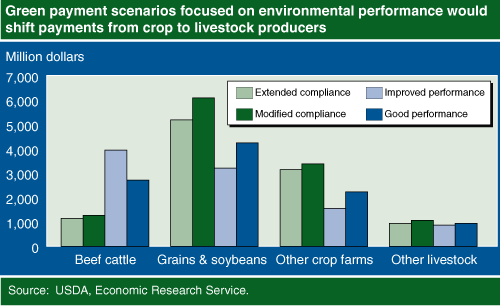Integrating Conservation and Commodity Program Payments: A Look at the Tradeoffs
- by Roger Claassen and Marcel Aillery
- 11/1/2007
Highlights
- A payment program that integrates characteristics of conservation and commodity programs could simultaneously support working farms and ranches while improving environmental quality, with some tradeoffs.
- If policymakers structure payments to focus on environmental gain, income support benefits would be more broadly distributed across the U.S. agricultural sector.
- If policymakers seek to preserve the existing distribution of commodity program payments within an integrated program, environmental gain would be lower and per unit costs of environmental benefits higher than under a similar program focused on conservation.
Can a single program support farm businesses while encouraging producers to adopt environmentally sound farming practices? That is the question underlying proposals to roll commodity program payments and conservation payments into a single program. This hybrid approach, sometimes referred to as “green payments,” would combine the farm income support feature of existing commodity programs with those of conservation incentive payments (see box, “Shades of Green”). Under such an integrated payment program, agricultural producers receiving commodity program payments would also work to improve their environmental performance (and vice versa)—an intuitively appealing quid pro quo.
The challenge of a green payments program is to meld conservation and commodity program payments into a single, workable whole. Commodity payments have a variety of intended goals, such as fostering an abundant supply of food and fiber and supporting and stabilizing farm income. Conservation programs are more narrowly focused on promoting environmentally sound farming practices.
Integrating commodity programs and conservation programs would require revisiting basic questions of program design: Who would be eligible for payments? How large would payments be? And what environmental actions would be required of producers who receive them? The answers to these questions will determine how much environmental gain would be realized and how income support benefits would be distributed across producers.
Although it is tempting to view a merger of commodity and conservation programs as a “win-win” proposition, policymakers would face tradeoffs in attempting to balance commodity and conservation objectives. At one level, the tradeoff is clear: for a given level of payment, the contribution to income declines as the cost of conservation increases. The portion of a payment that compensates agricultural producers for mandatory out-of-pocket costs, lost production, higher risk, and other costs associated with adoption of conservation practices does not contribute to the net income of the farm or ranch. A more subtle tradeoff may arise if agricultural operations eligible for commodity program payments differ from those that can produce the largest environmental gain per dollar of conservation cost. Policymakers could have to choose between (1) targeting payments to meet commodity objectives while sacrificing some environmental gain, or (2) targeting environmental gain while recognizing the possibility of shifting the distribution of payments away from producers and regions that have traditionally received commodity program support. Currently, recipients of the commodity program payments are largely producers of major field crops—grains, oilseeds, cotton, and rice.
Where You End Depends on Where You Begin
The level of environmental gain and distribution of commodity program payments depends largely on the starting point for program design—either existing commodity programs or conservation programs. Existing compliance provisions require soil conservation on highly erodible cropland and conservation of existing onfarm wetlands. Producers who fail to comply could lose commodity program payments. Policymakers could require additional conserving practices—such as nutrient management, pest management, and soil conservation on non-highly erodible land—as a condition for future payments. The net income support portion of such a payment would be equal to the total payment, less the costs associated with adopting conservation practices to address compliance requirements.
On the other hand, integrated payments could be viewed as an opportunity to refocus farm policy on environmental performance, or stewardship. Payments could encourage farmers and ranchers to produce environmental “goods and services,” such as clean water and wildlife habitat in the same way that market prices encourage production of traditional agricultural commodities like wheat, corn, or beef. Agricultural producers could do this, with respect to clean water for example, by controlling sediment, nutrient, or pesticide runoff from their operations. Payments could be commensurate with the level of environmental gain or environmental performance. Thus, producers who deliver the largest gain or the best performance, relative to the cost of their conservation practices, would receive the highest level of net income support.
An ERS study of green payment program options considered four hypothetical program scenarios (see box, “Defining and Modeling Program Scenarios”). The scenarios were developed for illustrative purposes only, and were not intended to mirror specific proposals. Rather, the scenarios were defined to capture key features of alternative program designs. The analysis is intended to show how program design might affect the environmental cost effectiveness of the program and the distribution of payments.
Getting the Most for Conservation Dollars
Conservation payments are environmentally “cost effective” when they produce the largest possible environmental gain for a given level of spending. Although both environmental performance and compliance scenarios leverage environmental gain, performance scenarios produce much larger environmental gains for a similar level of conservation expenditure. The differences in environmental cost effectiveness across the four green payment program scenarios are largely a function of three key determinants: the broadness of program requirements that define the pool of possible participants, the effectiveness of payment incentives in encouraging the participation of producers who can deliver large environmental benefits at low cost, and the flexibility that producers have in responding to payment incentives.
The Improved Performance scenario is the most environmentally cost-effective alternative, partly because virtually all farms are eligible to participate in the program. Moreover, as payments are proportional to environmental gain, participation incentives are focused on producers who can deliver large gains at low cost; such producers stand to make the largest monetary return on producing environmental benefits. Finally, program applicants are free to select which tracts of land are offered for program enrollment and which resource concerns are addressed on those tracts. Again, given the structure of payment incentives, producers will offer combinations of land and conservation treatments that yield large payments relative to practice adoption costs, thereby maximizing the return on program participation while providing cost-effective environmental gain.
The Good Performance scenario is slightly less cost effective in producing environmental gain because payments are structured around an environmental threshold that producers must reach before they qualify for payments. With this approach, producers who have already achieved a relatively high level of environmental performance are rewarded with payments based on environmental performance rather than environmental gain. No additional conservation is required to receive payments. At the same time, some producers who could make cost-effective environmental gains may decline to participate because they are required to reach the environmental threshold in order to receive payments.
Extended Compliance is the least environmentally cost-effective scenario. Eligibility is restricted to current commodity program participants, payments are not tied to the potential to deliver environmental gain, and producers are presented with a take-it-or-leave-it package of environmental requirements. To retain eligibility for income support payments, producers must satisfy all requirements regardless of cost (or environmental benefit). The Modified Compliance scenario is more environmentally cost effective than Extended Compliance because it allows producers to opt out of some requirements, with a reduction in payment proportional to the loss of environmental gain due to the opt-out. Environmental cost effectiveness is improved because producers are encouraged to drop expensive, low-benefit activities while complying with relatively high-benefit, low-cost requirements. Moreover, because producers are free to focus on cost-effective environmental gains, some producers who would not participate in Extended Compliance would probably sign up for Modified Compliance.
Scenario Implications for the Distribution of Green Payments
In attempting to merge programs that support farm operations with those that encourage environmentally sound farming and ranching practices, policymakers face tradeoffs. Although each of the green payment program approaches would result in substantial net income support for producers, the four scenarios result in very different distributions of income support across agricultural operations. The distribution of payments in the environmental compliance scenarios is similar to that under existing commodity programs. Net income support is different, however, because conservation costs vary across operations. On the other hand, the environmental performance scenarios result in a very different distribution of payments and net income support across farm types, commodity specializations, and regions.
The design features that make the environmental performance scenarios relatively cost effective at producing environmental gains—a broader pool of eligible participants and payments based on environmental performance—also drive the distribution of payments and income support. Under the environmental performance scenarios, smaller payments per farm operation are spread over an increased number of program participants, with a substantial share of payments allocated to producers who are not eligible for current commodity programs. Larger commercial farms (with gross annual sales of more than $250,000) continue to capture the largest share of overall payments. However, payments would generally increase for intermediate-sized operations and smaller rural-residence operations. The share of payments to producers of grain crops and cotton decreases, whereas the share to producers of livestock and other crops increases. Beef producers, in particular, would benefit if grazing lands become eligible for environmental performance-based payments. Regionally, payments would shift from the Corn Belt and Plains States, where grain production is concentrated, to areas where livestock and specialty crop production dominate.
If policymakers intend to refocus farm policy to enhance environmental stewardship, payments based on environmental performance would reallocate net income support across the sector. If policymakers want to maintain income support levels to traditional constituents of commodity programs, a compliance requirement may be a better option, although it will come at the cost of substantially smaller environmental gain.
This article is drawn from:
- Claassen, R., Aillery, M. & Nickerson, C. (2007). Integrating Commodity and Conservation Programs: Design Options and Outcomes. U.S. Department of Agriculture, Economic Research Service. ERR-44.
You may also like:
- Claassen, R. & Morehart, M. (2006). Greening Income Support and Supporting Green. U.S. Department of Agriculture, Economic Research Service. EB-1.




